Introduction to the Hadrosaurs
The “duck-billed” dinosaurs
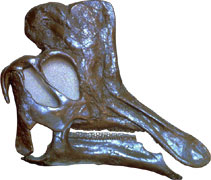
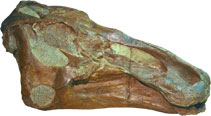 |
The "duckbilled dinosaurs" were common in the Upper Cretaceous of Europe, Asia, and North America. They were members of the Ornithopoda, and close relatives and possibly descendants of the earlier iguanodontid dinosaurs. Early interpretations of fossil skin impressions suggested that hadrosaur feet were webbed. Recent hypotheses, more consistent with what we know about the structure of ornithopod feet, suggest that hadrosaurs had pads similar to those seen on camel feet. Their stiff tails, supported by ossified tendons, and their sturdy bones and rapidly replaced teeth suggest that hadrosaurs spent most of their time on land, though close to bodies of water, feeding on tough terrestrial plants. The discovery of spectacularly preserved hadrosaur nests and young shows that hadrosaurs migrated to nesting grounds to reproduce.
There are two subfamilies of hadrosaurs, the Lambeosaurinae, which have a crest on the skull (like the top skull at right), and the Hadrosaurinae, which lacked the crest (like the bottom skull at right). The crest on a lambeosaur's skull contains the nasal passages, which "looped" through the crest and often formed sizeable chambers before passing into the airway. Why the crest? A number of hypotheses have been seriously suggested:
- the crest was a "snorkel" so that lambeosaurs could breathe while under water (but the crest had no opening to the outside, except for the nostrils);
- the crest warmed the air that the lambeosaurs were breathing (but lambeosaurs already lived in warm climates);
- the crest was an extra reservoir of air for swimming lambeosaurs (but it doesn't hold much air, and lambeosaurs probably didn't swim very much);
- the crest enabled lambeosaurs to breathe fire from their nose (but there's no evidence that the delicate bones of the nose were ever exposed to high temperatures regularly).
The most accepted theory today of the function of the crest is that it served as a resonating chamber, allowing lambeosaurs to make deep, loud sounds. Perhaps these calls warned of predators, or kept a herd together, or attracted potential mates, or did all these things. The crest may have also functioned as a visual display device in addition: perhaps large and odd-shaped crests attracted mates.
Now let's meet some of the duckbilled dinosaurs. Both Maiasaura and Edmontosaurus are hadrosaurines; they lack the crests of the lambeosaurs.
See Parasaurolophus, a crested lambeosaur, as it was exhibited in UCMP's former home in Minor Hall.
Baby Maiasaura
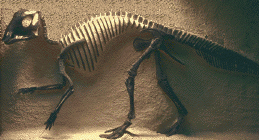 |
The fossil remains of young dinosaurs are very rare. This juvenile hadrosaur is a cast of one of the fifteen individuals of baby Maiasaura ("good mother lizard") collected in 1978 by Princeton University from the Upper Cretaceous (80-65 million years ago) Two Medicine Formation of Teton County in western Montana. The presence of several small skeletons, apparently all of the same species and size, together with eggshells, led paleontologists to discover the actual nest sites, where the hatchlings were apparently watched over and cared for by their parents.
A newly hatched hadrosaur was less than 14 inches long and weighed about 1.5 pounds. What did these baby dinosaurs eat? They ate fruits, leaves and other plant material that may have been brought to the nests by their parents. Since the parent duckbills were nearly 30 feet long and weighed about three tons, we assume that the dinosaurs were too large to incubate their eggs by sitting on the nest. Instead, warming for the eggs was provided when vegetation, placed on the nest, began to ferment. Modern crocodiles incubate their eggs in the same way.
Edmontosaurus, another hadrosaur
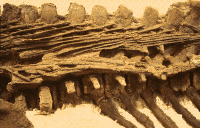 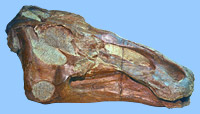 |
Edmontosaurus is from the same subfamily (Hadrosaurinae) as Maiasaura. One of the unique features of Edmontosaurus are the cross-bracing tendons in the tail, seen in the picture at left, that helped make the tail stiff and supporting. The tail was nearly impossible to bend, suggesting that it was not used as a paddle for swimming, as was once thought. Also, Edmontosaurus had the duck-billed skull shape shared by most hadrosaurs. The duck-billed shape is formed from a large hollow nostril (you can see the nostril opening on the skull). There is a gap between the "lips" of the skull; in life there would have been some fleshy or horny "bill" over the forward part of the mouth.
For more, visit Hoag Levins' exhibit on the discovery of Hadrosaurus foulkii, the first nearly-complete dinosaur skeleton to be discovered.
Source:
- Carroll, R.L. 1988. Vertebrate Paleontology and Evolution. W.H. Freeman and Company, New York.